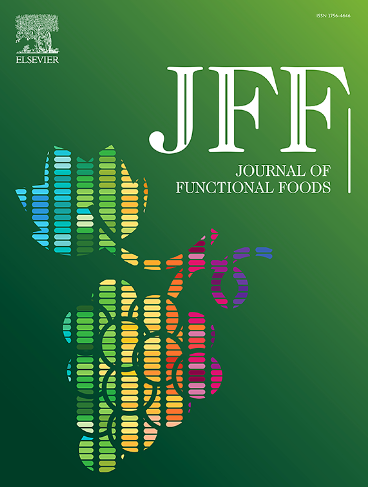刺蒺藜显著改善类风湿关节炎患者Th17/Treg失衡:伊朗一项随机双盲、安慰剂对照临床试验
IF 3.8
2区 农林科学
Q2 FOOD SCIENCE & TECHNOLOGY
引用次数: 0
摘要
目的:本研究通过随机、双盲、安慰剂对照的临床试验(IRCT20151028024760N5),探讨棘草对难治性女性RA患者临床、实验室指标及T淋巴细胞群的影响。材料和方法:30名知情的难治性类风湿性关节炎女性患者随机分为三组,分别为棘皮草组、安慰剂组和对照组。治疗方案连续3个月。干预前后分别评估患者VAS疼痛评分、DAS28、DAS28-ESR、ESR、CRP、RF、抗ccp抗体等参数。同时采集血样,流式细胞术检测CD4+ T、CD8+ T、Treg和Th17细胞的百分比。结果与结论:针刺治疗显著降低VAS疼痛评分(p = 0.0001)、DAS28 (p = 0.007)、DAS28-ESR (p = 0.001)、ESR (p = 0.003)、CRP (p = 0.026)水平。此外,木参处理显著增加了Treg种群(p = 0.02)和Treg/Th17比值(p = 0.0015),显著降低了Th17百分比(p = 0.04)。本文章由计算机程序翻译,如有差异,请以英文原文为准。
Capparis spinosa significantly improves Th17/Treg imbalance in patients with rheumatoid arthritis: A randomized double blind, placebo-controlled clinical trial in Iran
Aim: This study investigated the therapeutic effect of C. spinosa on clinical and laboratory indices, and the T lymphocyte populations in refractory female RA patients as a randomized, double-blind placebo-controlled, clinical trial (IRCT20151028024760N5). Materials and Methods: Thirty informed women with refractory RA were randomly divided into three groups including C. spinosa, placebo (, and control. The therapeutic regimen was continued for three consecutive months. Before and after the intervention, patients were evaluated for VAS pain score, DAS28, DAS28-ESR, ESR, CRP, RF, and anti-CCP antibody parameters. Blood samples were also collected to evaluate the percentage of CD4+ T, CD8+ T, Treg, and Th17 cells by flow cytometry. Results and conclusion: C. spinosa treatment significantly reduced VAS pain score (p = 0.0001), DAS28 (p = 0.007), DAS28-ESR (p = 0.001), ESR (p = 0.003), and CRP (p = 0.026) levels. In addition, C. spinosa treatment significantly increased the Treg population (p = 0.02) and Treg/Th17 ratio (p = 0.0015), while decreased Th17 percentage (p = 0.04).
求助全文
通过发布文献求助,成功后即可免费获取论文全文。
去求助
来源期刊

Journal of Functional Foods
FOOD SCIENCE & TECHNOLOGY-
CiteScore
9.60
自引率
1.80%
发文量
428
审稿时长
76 days
期刊介绍:
Journal of Functional Foods continues with the same aims and scope, editorial team, submission system and rigorous peer review. We give authors the possibility to publish their top-quality papers in a well-established leading journal in the food and nutrition fields. The Journal will keep its rigorous criteria to screen high impact research addressing relevant scientific topics and performed by sound methodologies.
The Journal of Functional Foods aims to bring together the results of fundamental and applied research into healthy foods and biologically active food ingredients.
The Journal is centered in the specific area at the boundaries among food technology, nutrition and health welcoming papers having a good interdisciplinary approach. The Journal will cover the fields of plant bioactives; dietary fibre, probiotics; functional lipids; bioactive peptides; vitamins, minerals and botanicals and other dietary supplements. Nutritional and technological aspects related to the development of functional foods and beverages are of core interest to the journal. Experimental works dealing with food digestion, bioavailability of food bioactives and on the mechanisms by which foods and their components are able to modulate physiological parameters connected with disease prevention are of particular interest as well as those dealing with personalized nutrition and nutritional needs in pathological subjects.
 求助内容:
求助内容: 应助结果提醒方式:
应助结果提醒方式:


